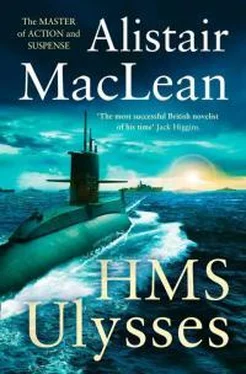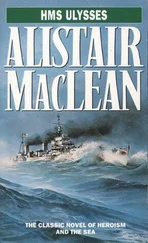A ghost-ship, almost, a legend. The Ulysses was also a young ship, but she had grown old in the Russian Convoys and on the Arctic patrols. She had been there from the beginning, and had known no other life. At first she had operated alone, escorting single ships or groups of two or three: later, she had operated without her squadron, the 14th Escort Carrier group.
But the Ulysses had never really sailed alone. Death had been, still was, her constant companion. He laid his finger on a tanker, and there was the erupting hell of a high-octane detonation; on a cargo liner, and she went to the bottom with her load of war supplies, her back broken by a German torpedo; on a destroyer, and she knifed her way into the grey-black depths of the Barents Sea, her still-racing engines her own executioners; on a U-boat, and she surfaced violently to be destroyed by gunfire, or slid down gently to the bottom of the sea, the dazed, shocked crew hoping for a cracked pressure hull and merciful instant extinction, dreading the endless gasping agony of suffocation in their iron tomb on the ocean floor. Where the Ulysses went, there also went death. But death never touched her. She was a lucky ship. A lucky ship and a ghost ship and the Arctic was her home.
Illusion, of course, this ghostliness, but a calculated illusion. The Ulysses was designed specifically for one task, for one ocean, and the camouflage experts had done a marvellous job. The special Arctic camouflage, the broken, slanting diagonals of grey and white and washed-out blues merged beautifully, imperceptibly into the infinite shades of grey and white, the cold, bleak grimness of the barren northern seas.
And the camouflage was only the outward, the superficial indication of her fitness for the north.
Technically, the Ulysses was a light cruiser. She was the only one of her kind, a 5,500-ton modification of the famous Dido type, a forerunner of the Black Prince class. Five hundred and ten feet long, narrow in her fifty-foot beam with a raked stem, square cruiser stern and long fo’c’sle deck extending well abaft the bridge – a distance of over two hundred feet, she looked and was a lean, fast and compact warship, dangerous and durable.
‘Locate: engage: destroy.’ These are the classic requirements of a naval ship in wartime, and to do each, and to do it with maximum speed and efficiency, the Ulysses was superbly equipped.
Location, for instance. The human element, of course, was indispensable, and Vallery was far too experienced and battlewise a captain to underestimate the value of the unceasing vigil of lookouts and signalmen. The human eye was not subject to blackouts, technical hitches or mechanical breakdowns. Radio reports, too, had their place and Asdic, of course, was the only defence against submarines.
But the Ulysses ’s greatest strength in location lay elsewhere. She was the first completely equipped radar ship in the world. Night and day, the radar scanners atop the fore and main tripod masts swept ceaselessly in a 360° arc, combing the far horizons, searching, searching. Below, in the radar rooms – eight in all – and in the Fighter Direction rooms, trained eyes, alive to the slightest abnormality, never left the glowing screens. The radar’s efficiency and range were alike fantastic. The makers, optimistically, as they had thought, had claimed a 40-45 mile operating range for their equipment. On the Ulysses ’s first trials after her refit for its installation, the radar had located a Condor, subsequently destroyed by a Blenheim, at a range of eighty-five miles.
Engage – that was the next step. Sometimes the enemy came to you, more often you had to go after him. And then, one thing alone mattered – speed.
The Ulysses was tremendously fast. Quadruple screws powered by four great Parsons singlereduction geared turbines – two in the for’ard, two in the after engine-room – developed an unbelievable horsepower that many a battleship, by no means obsolete, could not match. Officially, she was rated at 33.5 knots. Off Arran, in her full-power trials, bows lifting out of the water, stern dug in like a hydroplane, vibrating in every Clyde-built rivet, and with the tortured, seething water boiling whitely ten feet above the level of the poop-deck, she had covered the measured mile at an incredible 39.2 knots – the nautical equivalent of 45 mph. And the ‘Dude’ – Engineer-Commander Dobson – had smiled knowingly, said he wasn’t half trying and just wait till the Abdiel or the Manxman came along, and he’d show them something. But as these famous mine-laying cruisers were widely believed to be capable of 44 knots, the wardroom had merely sniffed ‘Professional jealousy’ and ignored him. Secretly, they were as proud of the great engines as Dobson himself.
Locate, engage – and destroy. Destruction. That was the be-all, the end-all. Lay the enemy along the sights and destroy him. The Ulysses was well equipped for that also.
She had four twin gun-turrets, two for’ard, two aft, 5.25 quick-firing and dual-purpose – equally effective against surface targets and aircraft. These were controlled from the Director Towers, the main one for’ard, just above and abaft of the bridge, the auxiliary aft. From these towers, all essential data about bearing, wind-speed, drift, range, own speed, enemy speed, respective angles of course were fed to the giant electronic computing tables in the Transmitting Station, the fighting heart of the ship, situated, curiously enough, in the very bowels of the Ulysses , deep below the water-line, and thence automatically to the turrets as two simple factors – elevation and training. The turrets, of course, could also fight independently.
These were the main armament. The remaining guns were purely AA – the batteries of multiple pompoms, firing two-pounders in rapid succession, not particularly accurate but producing a blanket curtain sufficient to daunt any enemy pilot, and isolated clusters of twin Oerlikons, high-precision, highvelocity weapons, vicious and deadly in trained hands.
Finally, the Ulysses carried her depth-charges and torpedoes – 36 charges only, a negligible number compared to that carried by many corvettes and destroyers, and the maximum number that could be dropped in one pattern was six. But one depthcharge carries 450 lethal pounds of Amatol, and the Ulysses had destroyed two U-boats during the preceding winter. The 21-inch torpedoes, each with its 750-pound warhead of TNT, lay sleek and menacing, in the triple tubes on the main deck, one set on either side of the after funnel. These had not yet been blooded.
This, then, was the Ulysses . The complete, the perfect fighting machine, man’s ultimate, so far, in his attempt to weld science and savagery into an instrument of destruction. The perfect fighting machine – but only so long as it was manned and serviced by a perfectly-integrating, smoothlyfunctioning team. A ship – any ship – can never be better than its crew. And the crew of the Ulysses was disintegrating, breaking up: the lid was clamped on the volcano, but the rumblings never ceased.
The first signs of further trouble came within three hours of clearing harbour. As always, minesweepers swept the channel ahead of them, but, as always, Vallery left nothing to chance. It was one of the reasons why he – and the Ulysses – had survived thus far. At 0620 he streamed paravanes – the slender, torpedo-shaped bodies which angled out from the bows, one on either side, on special paravane wire. In theory the wires connecting mines to their moorings on the floor of the sea were deflected away from the ship, guided out to the paravanes themselves and severed by cutters: the mines would then float to the top to be exploded or sunk by small arms.
Читать дальше
Конец ознакомительного отрывка
Купить книгу










